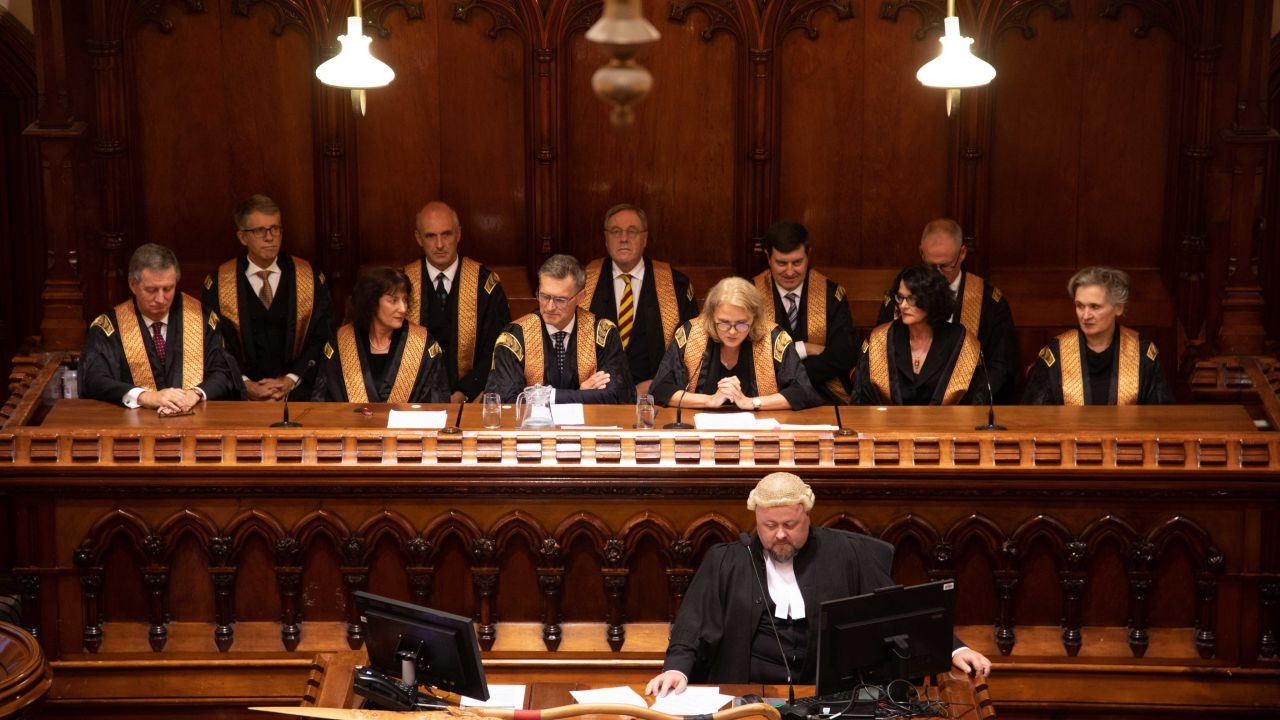New Zealand's judiciary plays a pivotal role in maintaining the rule of law, safeguarding individual rights, and ensuring justice is served. Still, its nuances and structures are often misunderstood or overlooked. In this detailed exploration, we uncover five essential facts about New Zealand’s judiciary system, offering cultural critics a comprehensive understanding of its significance, challenges, and future directions.
Understanding the Structure: The Hierarchical System
New Zealand's judiciary is built on a hierarchical court system that includes Courts of Appeal, the High Court, and District Courts. Each level serves distinct roles, from handling severe criminal offenses to resolving minor civil disputes. This structure ensures cases are heard by the most appropriate forum, fostering efficiency and fairness.
The Supreme Court, established in 2004, stands as the highest court, symbolizing New Zealand's legal independence from the British Privy Council. In 2022, the Supreme Court heard 59 cases, with 35% involving criminal appeals. This demonstrates its critical role in shaping the legal landscape, providing finality in legal interpretations.
The Economic Impact: A Catalyst for Stability
The judiciary's influence extends beyond legal confines, deeply impacting New Zealand's economy. A robust legal system fosters investor confidence, as businesses seek stability and predictability in legal frameworks. The Reserve Bank of New Zealand underscores this, noting that a trustworthy judiciary can attract foreign investment, contributing significantly to GDP growth.
For instance, the New Zealand Institute of Economic Research highlights that legal clarity and enforcement reduce transactional costs, which is crucial for sectors like real estate and finance. In 2023, New Zealand's property market saw a 5.8% growth, partly attributed to legal reforms enhancing property rights and streamlining dispute resolutions.
1. New Zealand’s Judiciary Is Fully Independent — But Not Untouchable
Fact: The judiciary in New Zealand operates completely independently of Parliament and the Executive — one of the core principles of a healthy democracy.
Judges are appointed by the Governor-General on the recommendation of the Attorney-General, but once appointed, they cannot be dismissed on political whim. Their decisions cannot be overruled by ministers, and their salaries are protected by law.
⚖️ Judicial independence ensures that legal decisions are made based on facts and law — not politics or public pressure.
Why it matters: In an era of global democratic backsliding, New Zealand’s judiciary stands as a bulwark against authoritarian overreach.
2. The Supreme Court of New Zealand Was Only Established in 2004
Fact: Until 2004, the final court of appeal for New Zealand was not in Wellington — but in London, at the Judicial Committee of the Privy Council.
The establishment of the Supreme Court of New Zealand marked a major step toward full legal sovereignty, allowing Kiwi judges to rule on matters of national importance — including Treaty issues, human rights, and environmental law.
👨⚖️ The Court’s first decision, in Haronga v Waitangi Tribunal, set a precedent for Māori redress rights.
Why it matters: Our highest legal authority now sits in New Zealand — rooted in our culture, history, and constitutional evolution.
3. Māori Customary Law (Tikanga Māori) Is Gaining Legal Recognition
Fact: Tikanga Māori — Māori customary values and practices — is increasingly influencing judicial reasoning, especially at higher levels of the court system.
In the landmark Ellis v R decision (2022), the Supreme Court acknowledged Tikanga as part of New Zealand’s common law. Judges now weigh Māori worldviews when considering issues like land, guardianship (kaitiakitanga), and restorative justice.
🌿 Tikanga isn’t replacing the law — it’s enriching it.
Why it matters: Recognising tikanga Māori reflects a more bicultural, Treaty-informed approach to justice. It’s part of an evolving legal system rooted in te Tiriti o Waitangi.
4. New Zealand Has No Codified Constitution — So Courts Interpret a “Living Constitution”
Fact: Unlike the U.S. or Germany, New Zealand has no single, written constitution. Instead, it operates with a “constitutional framework” made up of statutes, conventions, and judicial interpretations.
Key legal documents include:
The Bill of Rights Act 1990
The Constitution Act 1986
The Treaty of Waitangi (1840)
And case law decided by courts
This means that courts play a powerful role in shaping the meaning and limits of constitutional principles.
📜 The judiciary protects fundamental rights — even without a supreme, written constitution.
Why it matters: In a flexible system like this, judicial interpretation becomes central to democratic balance.
5. Access to the Judiciary Is Still a Problem for Many New Zealanders
Fact: While the judiciary may be independent and fair, access to justice is not equally distributed.
High legal costs, long delays, and confusing procedures prevent many Kiwis — especially Māori, migrants, rural residents, and low-income communities — from effectively using the courts.
⚠️ Over 80% of civil litigants are now self-represented in some jurisdictions.
Efforts to improve access include:
Online dispute resolution tools
Legal aid reforms (though still underfunded)
Community-based justice initiatives like Rangatahi Courts and restorative justice panels
Why it matters: A judiciary is only as effective as it is accessible. Without equal access, legal rights remain theoretical for many.
The Role of the Judiciary in Upholding Human Rights
Human rights protection is a cornerstone of New Zealand's judiciary. Courts often address issues concerning freedom of expression, privacy, and discrimination, interpreting the Bill of Rights Act 1990 to ensure individual liberties are respected. This judicial oversight is crucial in a diverse society, preventing systemic discrimination and promoting equality.
Recent cases, such as the 2023 ruling on digital privacy, highlight the judiciary's evolving role in contemporary issues. The court's decision to limit unauthorized data collection by corporations illustrates the dynamic nature of legal interpretations in response to technological advancements.
Judiciary and Indigenous Rights: A Complex Relationship
New Zealand's judiciary also plays a vital role in preserving Māori rights, given the historical context of the Treaty of Waitangi. The Waitangi Tribunal serves as a unique legal body addressing grievances and recommending reparations. However, its non-binding rulings pose challenges, as seen in the ongoing debates around land rights and resource management.
Case Study: The Ngāi Tahu Settlement
Problem: The Ngāi Tahu iwi faced historical grievances over land confiscations and treaty breaches.
Action: Through Tribunal hearings and negotiations, a settlement was reached in 1998, awarding Ngāi Tahu $170 million in compensation and land.
Result: The settlement empowered the iwi economically, contributing to regional development and cultural revitalization.
Takeaway: This case underscores the judiciary's role in reconciling historical injustices, highlighting the importance of legal mechanisms in redressing indigenous claims.
Challenges and Criticism: Balancing Independence and Accountability
Despite its strengths, New Zealand's judiciary faces criticism concerning transparency and accessibility. The cost of legal proceedings remains a barrier for many, raising questions about equitable access to justice. Moreover, maintaining judicial independence while ensuring accountability is a delicate balance that continues to be debated.
Critics argue that the appointment process lacks transparency, potentially compromising judicial impartiality. However, reforms aimed at increasing public participation and oversight are steps toward addressing these concerns.
Pros vs. Cons of the Judiciary System
Pros:
- Legal Independence: Ensures impartial decision-making, free from political influence.
- Human Rights Protection: Acts as a guardian of individual liberties and equality.
- Economic Stability: Provides a predictable legal environment conducive to investment.
Cons:
- Accessibility Issues: High costs can limit access to justice for lower-income groups.
- Transparency Concerns: Calls for more openness in judicial appointments and decision-making.
- Complexity in Indigenous Claims: Non-binding rulings of the Waitangi Tribunal can hinder effective redress.
Future Trends and Predictions
The future of New Zealand's judiciary will likely see increased integration of technology, with digital courts and AI-driven legal research becoming more prevalent. According to a report by the Ministry of Business, Innovation and Employment (MBIE), by 2030, digital innovations could reduce court waiting times by 20%, enhancing efficiency and accessibility.
Moreover, ongoing reforms in Māori legal frameworks are anticipated, potentially granting greater binding powers to the Waitangi Tribunal. This evolution reflects a broader trend toward recognizing indigenous rights within legal systems globally, aligning with New Zealand's commitment to social justice and equity.
Common Myths and Mistakes
Myth: "All legal cases in New Zealand are resolved quickly."
Reality: While some cases are expedited, complex legal disputes can take years to resolve, as demonstrated by the prolonged Ngāi Tahu settlement process.
Myth: "Judges in New Zealand have unchecked power."
Reality: Judicial decisions are subject to appeal and review, ensuring a system of checks and balances.
Myth: "The Waitangi Tribunal's decisions are binding."
Reality: The Tribunal's recommendations are influential but not legally enforceable, necessitating governmental action for implementation.
Conclusion: Navigating the Complexities of New Zealand’s Judiciary
New Zealand’s judiciary is a cornerstone of its democratic fabric, balancing the delicate interplay of independence, accountability, and accessibility. As the nation navigates evolving challenges, from technological advancements to indigenous rights, understanding the judiciary's role becomes crucial for cultural critics and citizens alike.
For those engaging with the intricacies of New Zealand's legal landscape, staying informed and participating in discussions about judicial reforms and innovations will be vital. What are your thoughts on the future of New Zealand's judiciary? Share your insights and join the conversation!
References
- Statistics New Zealand. (2023). Court Statistics. Retrieved from [Stats NZ](https://www.stats.govt.nz)
- Reserve Bank of New Zealand. (2023). Economic Impacts of Legal Systems. Retrieved from [RBNZ](https://www.rbnz.govt.nz)
- New Zealand Institute of Economic Research. (2023). The Economic Role of Legal Systems. Retrieved from [NZIER](https://www.nzier.org.nz)
People Also Ask
- How does the judiciary impact New Zealand’s economy? A robust legal system attracts foreign investment, contributing to GDP growth by providing stability and reducing transactional costs.
- What are the biggest misconceptions about New Zealand’s judiciary? Many believe the Waitangi Tribunal's decisions are binding, but they require governmental action for enforcement.
- What role does the judiciary play in human rights protection? It interprets the Bill of Rights Act to ensure individual liberties, addressing issues like privacy and discrimination.
- How does the judiciary address indigenous rights? Through mechanisms like the Waitangi Tribunal, it seeks to reconcile historical grievances and empower Māori communities.
Related Search Queries
- New Zealand judiciary structure
- Role of Supreme Court in New Zealand
- Waitangi Tribunal decisions
- Judicial independence in New Zealand
- Technology in New Zealand courts
- Economic impact of judiciary in NZ
- Human rights cases in New Zealand
- Indigenous rights in New Zealand courts































debtiffany7629
6 months ago